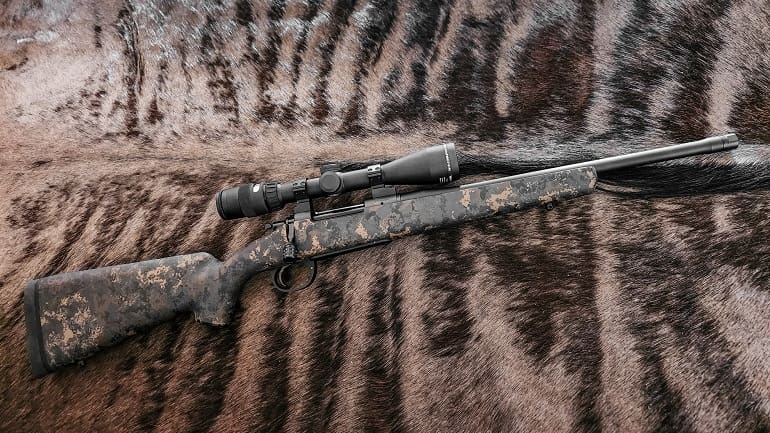When I picked up the soft case, I genuinely thought Wilson Combat had shipped me an empty one. That’s how absurdly light this rifle is. But the moment I unzipped it, I knew I was holding something special—the latest evolution from Wilson Combat, a precision .308 Winchester bolt-action rifle tipping the scales at a mere 4 pounds, 15 ounces. Introducing the Wilson Combat NULA Model 20, a rifle that doesn’t just meet expectations—it exceeds them in ways that redefine what a lightweight hunting rifle can be.
I’ve been waiting for this moment ever since Wilson Combat acquired New Ultralight Arms (NULA) from its legendary founder, Melvin Forbes. If you’ve followed ultralight rifles, you know Forbes was decades ahead of his time. Back in 1985, he introduced the original Model 20, a sub-5-pound bolt gun that serious hunters swore by. I never had the chance to shoot one back then, but I read everything I could about them. They were expensive, they were exclusive, and they were engineered to perfection.
I’ll admit, I was a little surprised when Forbes sold NULA. Historically, selling to a big company hasn’t always gone well—Colt once owned Ultralight Arms, and, well, let’s just say they dropped the ball. But Wilson Combat is a different beast. Bill Wilson and Melvin Forbes share an obsession with precision and quality, making this a partnership worth watching.
The NULA Model 20 is a marvel of efficiency. It’s called the Model 20 because the action weighs—wait for it—20 ounces. That’s right, the entire action weighs as much as a large cup of coffee. And no, it’s not made of titanium or some exotic space-age metal. It’s good old-fashioned 4140 steel, meticulously designed and machined to perfection. The bolt? EDM cut from ultra-strong 4340 steel. No unnecessary skeletonizing, no excessive fluting—just a masterpiece of minimalism.
The genius of this rifle isn’t just in the materials; it’s in the engineering. Most manufacturers build actions to accommodate multiple cartridges, making them bigger and heavier than necessary. Not here. The Model 20 is purpose-built for a specific range of cartridges, allowing it to be precisely as large as it needs to be—nothing more, nothing less.
The bolt operation is a dream. There’s no slop, no unnecessary movement—just smooth, crisp function. It’s a two-lug design with a traditional claw extractor and a beefy plunger ejector. A red cocking indicator adds a nice visual touch. The carbon fiber stock, the same material Forbes pioneered back in the day, keeps the rifle rigid and feather-light. What was once a revolutionary concept is now standard in high-end ultralight rifles, but back in the ‘80s, Forbes was ahead of his time.
One feature I love is the internal box magazine with a four-round capacity and a hinged floorplate. It’s practical, elegant, and functional—no added tension when running it 4+1. The rifle is pillar-bedded, and reassembling it confirmed something I always appreciate—precision-built parts that fit together only one way, the right way.
And then there’s the finish—because Wilson Combat doesn’t cut corners. The barrel sports their Armor-Tuff coating, the bottom metal is hard anodized, and the receiver and bolt get ArmorLube’s DLC treatment—probably the best anti-friction and long-term wear-resistant finish available. The result? A rifle that still looked brand new even after I’d put it through its paces.
Wilson Combat wisely chose a Timney Elite Hunter trigger for the Model 20, and it delivers. My Lyman digital trigger scale averaged 3 pounds, 0.1 ounces over five pulls, with a total extreme spread of just over 1 ounce. If there’s creep or slack, you’d need a microscope to find it. The two-position safety locks the bolt when engaged—a small but welcome feature.
The rifle shoulders beautifully. The stock geometry is spot-on, and the grippy finish keeps it locked in place. The oversized bolt handle is easy to grab, and the action is smooth enough to let you cycle rounds without breaking sight alignment. Plenty of heavier rifles can’t claim that.
At just 16 inches, the Wilson Combat-made, button-rifled 416R stainless steel barrel is compact. I’ll be honest—I’m not usually a fan of 16-inch barrels in .308, but there’s no denying the advantage when weight savings is the goal. In the hands of a skilled shooter, this rifle can confidently take down any North American game animal out to 300 yards. If you prefer a longer barrel, Wilson Combat offers a 20-inch version in 7mm-08, which only adds a few ounces to the total weight.
Accuracy? It’s ridiculous. Wilson Combat guarantees sub-MOA performance, and my results backed that up. I tested IMI’s M118LR, Wilson Combat’s 175gr SMK, Hornady’s 165gr Copper Solid, and Lehigh Defense’s 152gr and 125gr Controlled Chaos rounds. Not a single five-shot group exceeded 1 inch at 100 yards, with most falling between 0.6 and 0.8 inches. That was with a Caldwell Stinger rest and a Trijicon Accupoint at 9X. I have no doubt an even higher-magnification optic would tighten those groups further.
Now, let’s talk about the tradeoff—because there is one. When a rifle is this light, you feel every bit of recoil. I usually run 100 rounds per session for bolt-action reviews, sometimes 500 rounds total. This time? Fifty rounds per session was plenty. Shooting offhand or kneeling isn’t bad, but from the prone position, the recoil is… memorable. The Decelerator recoil pad helps, but a suppressor on the threaded barrel helps even more.
After 300 rounds, the rifle performed flawlessly. Not a single issue. Not a single hiccup. Just consistent, repeatable excellence.
Wilson Combat has done right by Melvin Forbes. The NULA Model 20 isn’t just a lightweight rifle—it’s a statement. It’s proof that great American craftsmanship still exists, that innovation and tradition can coexist, and that a rifle built for a purpose can still exceed all expectations. It’s impossibly light, exceptionally accurate, and engineered with an obsessive attention to detail.
Simply put: the NULA Model 20 is a masterpiece.


